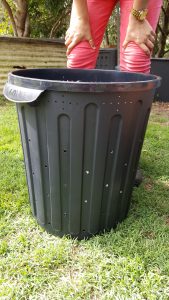Having a worm farm at home is a fantastic way to disappear your food scraps and transform them into wonderfully fertile soil. Having earthworms in your soil is like having a secret team looking after the health of your plants, and the planet!
If you have trouble keeping things alive (your worms or your plants), here is a simple, efficient and inexpensive system that you can set up just about anywhere.
But first, a bit about us and a bit about wonderful earthworms.
We are Lee and Kirsty of Island Biologicals, and it’s our mission to add life to your plants. We run a commercial worm farm on Oxley Island which we feed with composted local ‘waste’ materials. We’re a bit unusual though, because we don’t sell worms!
Instead, we’re most interested in what comes out the worm’s back end. Our flagship product is a plant probiotic called ‘Biocast+’, made as a liquid extract of worm cast. We are chuffed that it’s gaining a strong following in agricultural circles across Australia as a high quality biostimulant with great results.
There’s a good reason why plants respond so well to products such as Biocast+, and earthworms enjoy such a great reputation for generating fertility. They are nature’s perfect design for building rich soil!
Their front end is an organic matter reducer and shredder. Worms will eat anything that was once alive, but nothing that is currently living. Did you know that worms actually get most of their protein from the microbes living on decomposing organic matter? In your home worm farm this means the finer you can chop your scraps, the better. It provides more surface area for microbes to get into.
Their middle is an anaerobic bacterial fermentation system (kind of like the crock you make sauerkraut in). This is where the magic happens. Microbes within the gut help the worm to process that organic material. Nutrients are unlocked, beneficial plant-relevant microbes proliferate, and so do their growth-stimulating byproducts such as enzymes and growth hormones.
The worms’ back end is a perfect biostimulant distribution system, straight to where it’s needed at the plant root. Worm tunnels also act to aerate the soil and provide means for water to soak deeply.
Types of Earthworms
There are many different types of earthworms. Compost worms are the ones for your worm farm. As the name suggests, these live in organic matter. They do not burrow. Other earthworms are shallow and deep tunnelling varieties. These are the ones you will (hopefully) find when you dig around in your garden.
The system we share below lets you get the superior organic matter breakdown benefits of the compost worms, plus the distribution and aeration benefits of tunnelling worms.
We call it the worm hotel. Examples are set up and functioning at all our local community gardens. They are fantastic for putting straight in your veggie bed.
You need:
- 1 large plastic container such as a bucket or garbage bin, sturdy pot or large-diameter pvc pipe cutoff
-
A drill (or something to punch holes)
-
A shovel
-
Bedding for your worms, such as aged compost, shredded and moistened brown cardboard, or newspaper soaked in the water from your boiled potatoes.
-
1000 compost worms (standard starter pack) [NB. Given that we don’t sell worms, if you need them you can support another local business and get them from Peter and Anna at wormbiz.com.au.]
Instructions:

- Get your container and drill 25mm holes in it through the base and 12mm holes through the lower 3/4 of the sides. These are to let tunnelling worms in and out and drain excess liquid. You can drill in any design you like!
-
Also drill a few small 3mm holes around the top, for ventilation.
-
Next dig a hole in your garden where you want the worm hotel to go, to the depth of the holes in your bucket (i.e. so the drainage holes are all underground with ventilation holes above the surface). Straight in your veggie patch or flower bed is a great place!
-
Place in hole and backfill so it sits nice and snug in the ground.
-
Lay some bedding in at the base of your bucket to a depth of about 10 cm, and add your compost worms.
-
Make sure to pop a lid on to keep out rain and pests. If it’s in any full sun you might also need to put something over for insulation, like a folded up old blanket or a biscuit of hay.
-
Put your scraps in and keep an eye on how quickly the worms eat them. Feed accordingly! If it looks very dry add some water. If it looks very wet add shredded paper or cardboard, or dried leaves. A sprinkling of lime every now and then won’t go astray.
Enjoy the benefits of an underground workforce in your garden!
You can find out more about us on our website at www.biocast.com.au, or find us on Facebook and Instagram @islandbiologicals.
